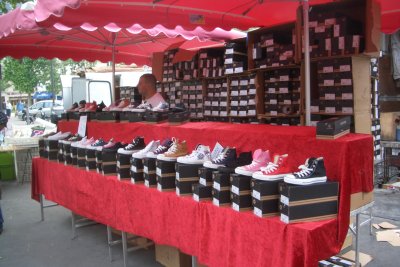
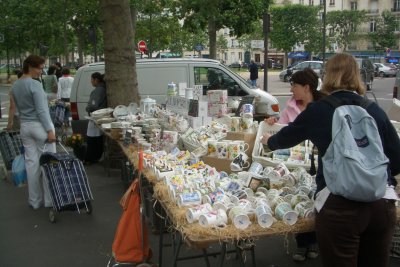
.jpg)
(Written 5 June 2008)
The Avenue de Saxe market is pretty full-service. I didn't see any stalls offering, e.g., banking or insurance services, and the neighborhood's not very ethnic, so the range of exotic foods wasn't as great as at some markets, but the offerings were still pretty comprehensive.
Those who know my predilections will not be surprised that I concentrated my attention on the food offerings, but here's a selection of the nonfood items on offer: shoes, china (with an emphasisis on brightly painted coffee mugs), and miscellaneous housewares. Lots of people were also selling, e.g., clothing (men's and women's, ethnic and "ordinary," serious and frivolous), t-shirts, leather goods, hats, knicknacks, watches and clocks, bed and table linens—whatever you needed.


.jpg)
The vegetable offerings definitely put Tallahassee seriously in the shade. The wide variety of lettuces were all gorgeous, fresh clean, and unbruised, as were the herbs (note the large pinkish bulbs of fresh garlic behind the bundles of herbs, their stems and skins still fresh and unshriveled). The selection of vegetables was wide but, at this time of year, featured sun-loving veggies from further south (tomatoes, eggplant, peppers, fennel), root vegetables that overwinter (carrots, beets, turnips, onions), and early-spring items (white asparagus, new leeks, spring onions, green peas, baby lettuces). The selection of mushrooms didn't include anything we consider too exotic (from the foreground backward: shiitaki, oyster mushrooms, mousserons, radishes, brown "domestic" mushrooms, white ones, and chanterelles—the selection will be wider in the fall). Strangely, I didn't see morels in the market, although all the restaurants of pretension are featuring them just now.
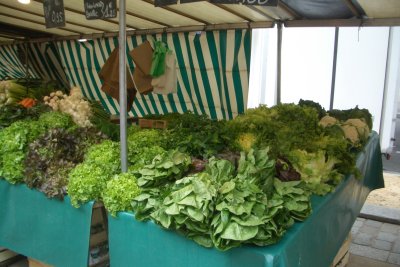
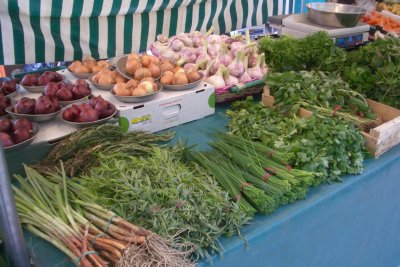 The photo with the red basket resting on the scales shows, left to right in the foreground, white asparagus, chanterelles, clusters of baby plum tomatoes on the vine and, behind them, fuzzy green fresh almonds (fresh almonds look like small shrivelled green peaches—in fact, they're very closely related—you peel off the "fruit" and crack the seed to get to the tender, crisp, and juicy green almond), and big purple figs the size and color of baby eggplants. Across the counter in the back are a selection of potato varieties (a different vender sold just potatoes, at least twelve kinds). Among this impressive display of olive varieties (the stall smelled delicious for yards around), including all colors and sizes, marinated and unmarinated, were bins of marinated broad beans, pickled garlic cloves, salt-preserved lemons, roasted peppers, mixed pickled veggies, pickled mushrooms, plain sour pickles, etc., etc.
The photo with the red basket resting on the scales shows, left to right in the foreground, white asparagus, chanterelles, clusters of baby plum tomatoes on the vine and, behind them, fuzzy green fresh almonds (fresh almonds look like small shrivelled green peaches—in fact, they're very closely related—you peel off the "fruit" and crack the seed to get to the tender, crisp, and juicy green almond), and big purple figs the size and color of baby eggplants. Across the counter in the back are a selection of potato varieties (a different vender sold just potatoes, at least twelve kinds). Among this impressive display of olive varieties (the stall smelled delicious for yards around), including all colors and sizes, marinated and unmarinated, were bins of marinated broad beans, pickled garlic cloves, salt-preserved lemons, roasted peppers, mixed pickled veggies, pickled mushrooms, plain sour pickles, etc., etc.
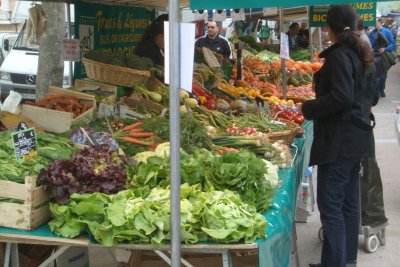
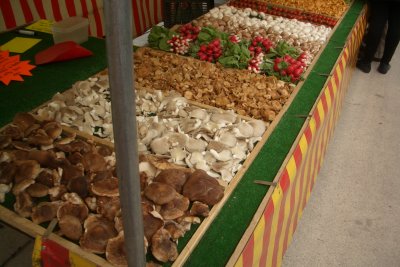
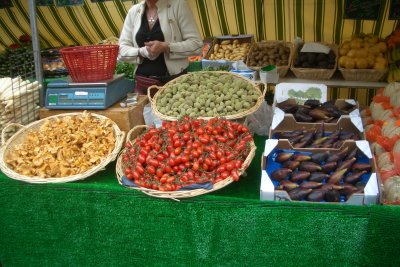
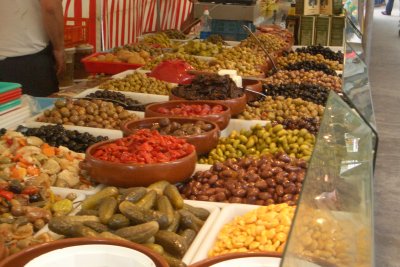
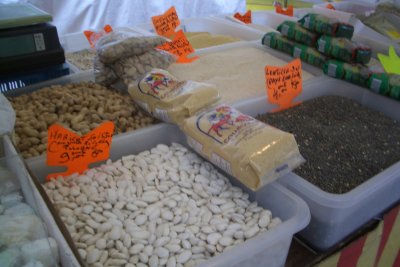
Besides this assortment of dried beans and lentils, this stall offered olive oils and honeys. I guess I didn't happen to photograph any of the large assortments of candies and nuts.
.jpg)
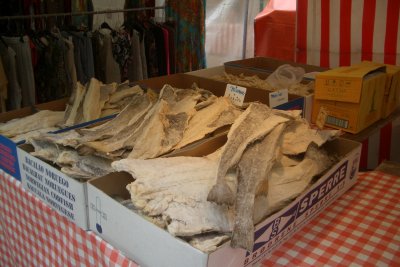
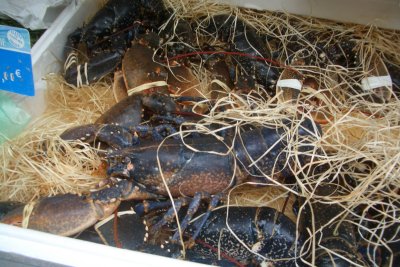
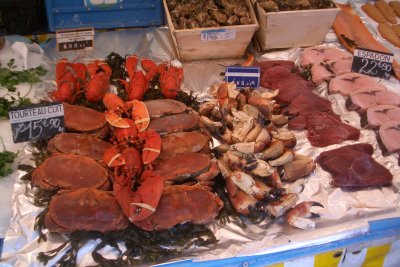 The fish and seafood offerings were magnificent, starting with sides of dried salt stacked like cordwood (they also had huge slabs of finnan haddie) and running through the complete gamut of fresh fish (more species in this entirely routine market than Tallahassee could dream of, though I didn't see any conger eel, just ordinary eels), both whole and cut up, some already stuffed or breaded, ready for cooking. They included bins of live crustaceans and bivalves (the French eat many more kinds of molluscs than we do—any seafood restaurant or market offers half a dozen varieties of oysters in several sizes each, plus mussels, whelks, periwinkles, and up to a dozen kinds of clams/cockles). Among the live lobsters was a monster, at least 4-5 lbs., and you can judge the scale of the smooth rounded "tourteaux" crabs among the cooked crustaceans if you keep in mind that the cooked lobsters are the usual pound to pound-and-a-quarter size.
The fish and seafood offerings were magnificent, starting with sides of dried salt stacked like cordwood (they also had huge slabs of finnan haddie) and running through the complete gamut of fresh fish (more species in this entirely routine market than Tallahassee could dream of, though I didn't see any conger eel, just ordinary eels), both whole and cut up, some already stuffed or breaded, ready for cooking. They included bins of live crustaceans and bivalves (the French eat many more kinds of molluscs than we do—any seafood restaurant or market offers half a dozen varieties of oysters in several sizes each, plus mussels, whelks, periwinkles, and up to a dozen kinds of clams/cockles). Among the live lobsters was a monster, at least 4-5 lbs., and you can judge the scale of the smooth rounded "tourteaux" crabs among the cooked crustaceans if you keep in mind that the cooked lobsters are the usual pound to pound-and-a-quarter size.
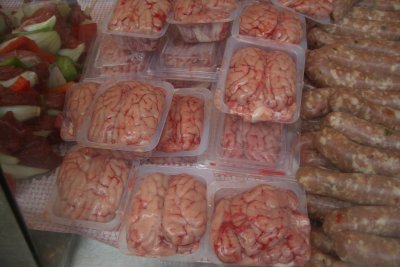
The butcher-shop displays proved difficult to photograph, but they included, in addition to the usual beef, pork, lamb, chicken, and turkey (not so much turkey), horsemeat, goat, guinea fowl, quail, poussin (baby chicken), game hen, pheasant, rabbit, and many cuts and organs of all of the above that we seldom see. Also all kinds of sausages, both raw and cooked, fresh, smoked, or dried. Each of these little half-pint plastic bins holds the raw brain of a lamb, so I guess the EU has concluded that the whole mad-cow thing is under control. Brains were banned from menus for a while there.
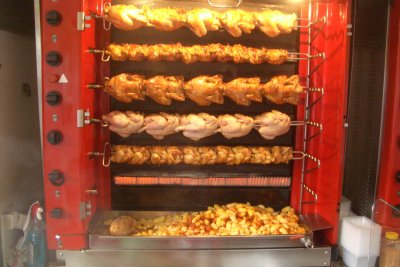
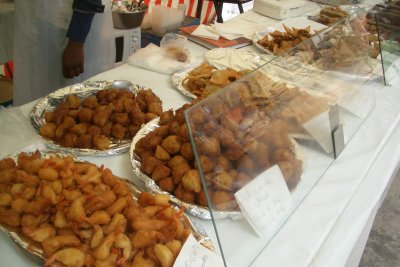
The cooked offerings were also extensive. You could pick up your festive Saturday lunch ready-made (cooked veggies and veggie salads were also available, by the pound). This rotisserie is loaded with chickens and poussins in various stages of doneness; note the heap of little round new potatoes in the bottom, roasting slowly in the drippings from the chickens. Other rotissieries were turning out other poultry and all sorts of roasts, particularly pork, which you could buy whole or by the pound. As each batch was done, it was transferred to the warming tables for sale. If I had been shopping for a larger meal, I would have bought one of the legs of suckling pig, roasted whole with the foot still attached—smaller than a leg of lamb, caramel colored, and practically falling off the bone.
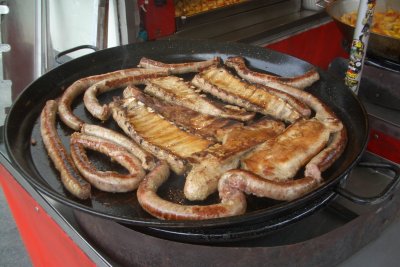
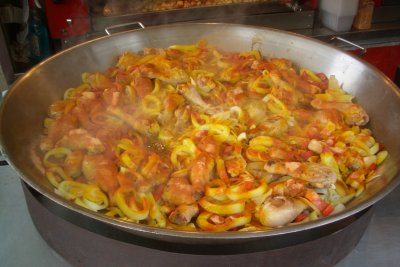
When I first walked by, the larger of these two pans was filled with sausages and pork ribs, sizzling appetizingly, and the smaller with chicken parts, onions, whole small langoustines, and large rings of squid sautéing with red spices.
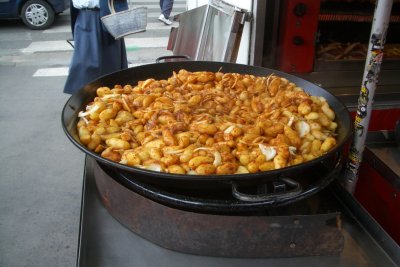
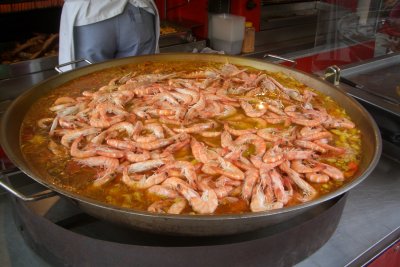
The last time I walked by, the sausages and ribs had been moved to the warming table, and these potatoes and onions were cooking in their drippings. The smaller pan was on its way to becoming paella; liquid, rice, and shrimp had been added, and the whole thing was coming back to the simmer. Toward the end, bivalves would be stuck down into it, and vegetables scattered over the surface. The whole thing would be done in time for lunch.
Boy, would I like to have a market like that located somewhere near my kitchen!
previous entry List of Entries next entry